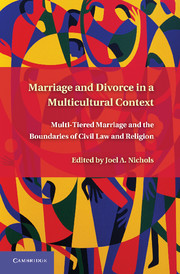 Marriage and Divorce in a Multi-Cultural Context
Marriage and Divorce in a Multi-Cultural Context Book contents
- Frontmatter
- Contents
- Detail Contents
- About the Editor
- List of Contributors
- Preface
- Permissions
- Introduction
- 1 Multi-Tiered Marriage
- 2 Pluralism and Decentralization in Marriage Regulation
- 3 Marriage and the Law
- 4 Unofficial Family Law
- 5 Covenant Marriage Laws
- 6 New York’s Regulation of Jewish Marriage
- 7 Political Liberalism, Islamic Family Law, and Family Law Pluralism
- 8 Multi-Tiered Marriages in South Africa
- 9 Ancient and Modern Boundary Crossings Between Personal Laws and Civil Law in Composite India
- 10 The Perils of Privatized Marriage
- 11 Canadian Conjugal Mosaic
- 12 Marriage Pluralism in the United States
- 13 Faith in Law? Diffusing Tensions Between Diversity and Equality
- 14 The Frontiers of Marital Pluralism
- Index
- References
5 - Covenant Marriage Laws
A Model for Compromise
Published online by Cambridge University Press: 05 November 2011
- Frontmatter
- Contents
- Detail Contents
- About the Editor
- List of Contributors
- Preface
- Permissions
- Introduction
- 1 Multi-Tiered Marriage
- 2 Pluralism and Decentralization in Marriage Regulation
- 3 Marriage and the Law
- 4 Unofficial Family Law
- 5 Covenant Marriage Laws
- 6 New York’s Regulation of Jewish Marriage
- 7 Political Liberalism, Islamic Family Law, and Family Law Pluralism
- 8 Multi-Tiered Marriages in South Africa
- 9 Ancient and Modern Boundary Crossings Between Personal Laws and Civil Law in Composite India
- 10 The Perils of Privatized Marriage
- 11 Canadian Conjugal Mosaic
- 12 Marriage Pluralism in the United States
- 13 Faith in Law? Diffusing Tensions Between Diversity and Equality
- 14 The Frontiers of Marital Pluralism
- Index
- References
Summary
Three American states – Louisiana, Arizona, and Arkansas – statutorily authorize couples to enter into a “covenant marriage.” These covenant marriage statutes incorporate into law, in varying degrees, the understanding of traditional marriage as historically recognized in Western countries – a sexually monogamous union between one man and one woman intended to be for life. Further, covenant marriage attempts to lessen the problems of divorce by strengthening the institution of marriage. John Witte explains the logic well:
The Western tradition has learned, through centuries of experience, to balance the norms of marital formation, maintenance, and dissolution.… The lesson in this is that rules governing marriage formation and dissolution must be comparable in their stringency. … Loose formation rules demand loose dissolution rules, as we see today. To fix “the modern problem of divorce” will require reforms of rules at both ends of the marital process.
What is covenant marriage?
Covenant evokes a rich heritage both in the law, as a special form of contract with specific formalities and greater binding force, and in religion, as an unbreakable and perpetual agreement between the Creator and mankind. The word covenant added as an adjective preceding marriage carries with it that rich heritage from dual sources to imbue and renew our understanding of a very old, yet indispensable, social institution. As Max Stackhouse describes a covenant’s effect:
[t]he sociotheological idea of covenant is so rich with ethical content that it gives moral meaning to all it touches.… [A] covenant shifts the terms of … relationships. [A covenant] is not cut casually, for it entails not only celebration and sacrifice but also the incorporation of new shared duties and rights that nourish life with other meanings, and thus a sense that these duties and rights are based on an enduring law and purpose as established by a higher authority.
- Type
- Chapter
- Information
- Marriage and Divorce in a Multi-Cultural ContextMulti-Tiered Marriage and the Boundaries of Civil Law and Religion, pp. 120 - 137Publisher: Cambridge University PressPrint publication year: 2011


